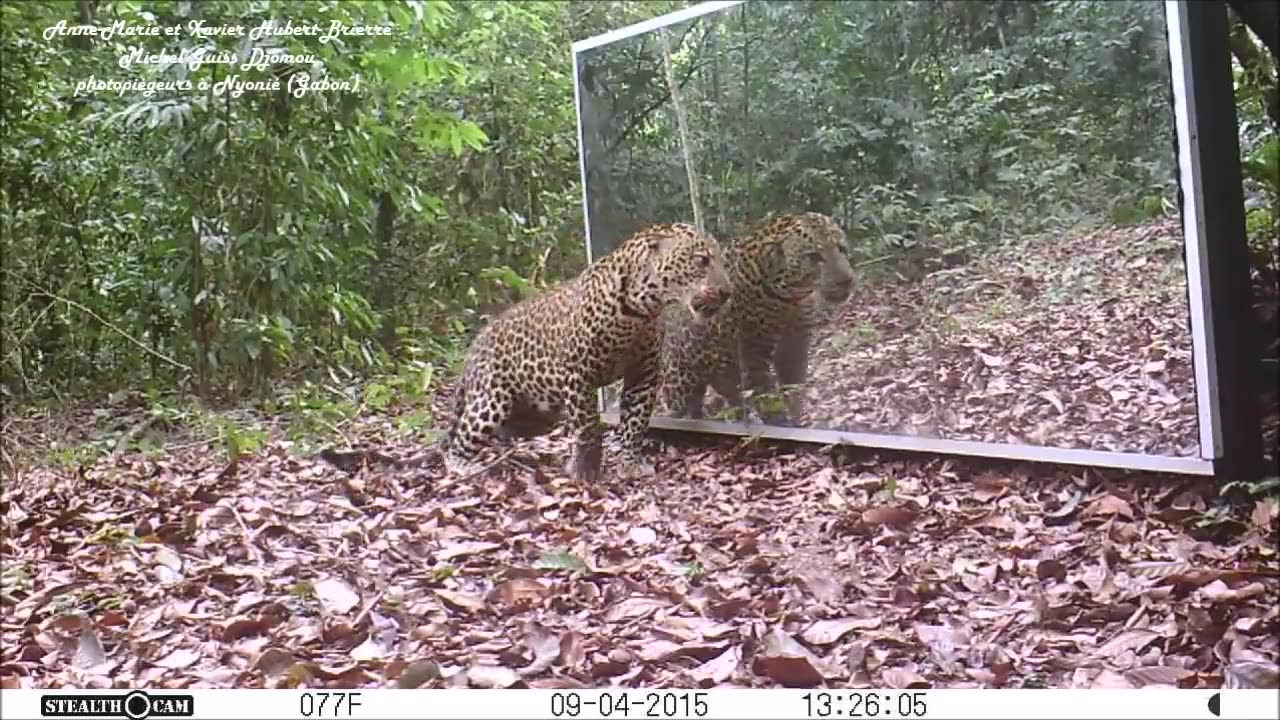Premium Only Content

Gabon' Jungle: An Elephants Family Refuses To Share A Big Mirror With A Leopard
𝐑.𝐈.𝐏. 𝐇𝐞𝐚𝐝𝐩𝐡𝐨𝐧𝐞 𝐔𝐬𝐞𝐫𝐬 Description English/French :
𝗧𝗵𝗶𝘀 𝗶𝘀 𝗾𝘂𝗶𝘁𝗲 𝗻𝗮𝘁𝘂𝗿𝗮𝗹 𝗮𝘀 𝘁𝗵𝗲 𝗺𝗮𝘁𝗿𝗶𝗮𝗿𝗰𝗵 𝗮𝗻𝗱 𝗵𝗲𝗿 𝗼𝗹𝗱𝗲𝗿 𝗰𝗵𝗶𝗹𝗱𝗿𝗲𝗻 𝗵𝗮𝘃𝗲 𝘁𝗼 𝗽𝗿𝗼𝘁𝗲𝗰𝘁 𝘁𝗵𝗲 𝗵𝗲𝗿𝗱'𝘀 𝗯𝗮𝗯𝗶𝗲𝘀 𝗳𝗿𝗼𝗺 𝗮 𝗹𝗲𝗼𝗽𝗮𝗿𝗱, 𝘁𝗵𝗲𝗶𝗿 𝗺𝗮𝗶𝗻 𝗽𝗿𝗲𝗱𝗮𝘁𝗼𝗿 𝗮𝗳𝘁𝗲𝗿 𝗽𝗼𝗮𝗰𝗵𝗲𝗿𝘀.
𝗔𝘁𝘁𝗮𝗰𝗸 𝗶𝘀 𝘁𝗵𝗲 𝗯𝗲𝘀𝘁 𝗱𝗲𝗳𝗲𝗻𝗰𝗲! 𝗣𝗿𝗲𝘃𝗲𝗻𝘁𝗶𝗼𝗻 𝗶𝘀 𝗯𝗲𝘁𝘁𝗲𝗿 𝘁𝗵𝗮𝗻 𝗰𝘂𝗿𝗲!
In a remote area of the Gabonese forest, 12 km from the equator and 10 km from the Atlantic Ocean, outside a national park, Anne-Marie et Xavier Hubert-Brierre have been observing the reaction of wild animals as they catch sight of themselves in large mirrors (250cm x 120cm) with motion sensors camera traps the couple installed 9 years ago. This innovative idea attracted the attention of primatologists, behaviour specialists whose studies on self recognition have, until now, been carried out in laboratories, on wild animals in captivity who are accustomed to the presence of humans. Wild animals come and go as they please in front of our mirrors and stay as they like both day and night.
For humans self recognition is not immediate: in the case of the very young child a period of “mirror training” guided by the reassurance of the mother is necessary.
For wild animals who haven't had this mirror training, nor possess the use of language to guide and reassure their child, self recognition is much more difficult.
Let's take the example of a gorillas family: Adult males see their reflection as a stranger come to seize his females. Young animals, on the other hand, see their reflection as a friend and companion. They don't hesitate to touch the surface of the mirror or reach behind the mirror in an effort to touch the image. Rebekah, a young student of Professor Jim Anderson, of the University of Sterling in Scotland, concluded her researched, based on our videos of a young male gorilla in front of our mirrors by stating, “this gorilla has demonstrated the ability to recognise himself.” Translated by Robin Alcorn
For leopard fanatics, (Panthera pardus and not Panthera onca (jaguar) only found on the American continent where no elephants are found on this continent) I publish a 19-minutes long video containing all the leopard's trap camera shots (assembled end to end) in front of this mirror from 13 PM before his meeting with elephants, during the face to face and after until he left the mirror at 23PM
https://youtu.be/aYkF84-adOo
Also a second short version taken by another trap camera of a different brands and under slightly different angle of view, have already been published on my channel, https://youtu.be/taoJDXZQx5s
-----------------------------------------
Dans la forêt gabonaise, Anne-Marie et Xavier Hubert-Brierre ont installé des grands miroirs afin de filmer sous différents angles avec des caméras équipées de détecteurs de mouvement, les réactions des animaux face à leur image. Cette idée novatrice a séduit des primatologues, spécialistes du comportement, dont les études, sur la reconnaissance de soi, ont réalisées jusqu’à présent en laboratoire sur les animaux sauvages en captivité, habitués à une présence humaine.
Devant nos miroirs les animaux sauvages s’y rendent comme bon leur semble et y restent à leur guise de jour comme de nuit.
Chez les humains la reconnaissance de soi dans un miroir n’est pas immédiate : Pour le tout jeune enfant, une période « d’apprentissage au miroir » sous les regards rassurants de sa mère, est nécessaire.
Chez les animaux sauvages, les mères n’ayant, elles-mêmes, pas suivi cet apprentissage, se reconnaître dans un miroir est beaucoup plus difficile d’autant plus qu’ils n’ont pas la parole pour expliquer et rassurer leurs enfants.
Prenons l'exemple d'une famille de gorilles : Les mâles adultes voient en leur image un étranger venu s’emparer de leurs femelles. Par contre les jeunes voient en leur image un ami, un compagnon. Ils n’hésitent pas à toucher la surface plane du miroir, à passer le bras derrière le miroir pour tenter de toucher leur image.
Rebekah, une jeune étudiante du Professeur Jim Anderson de l’université de Sterling en Ecosse, conclue dans sa thèse réalisée sur nos vidéos d’un jeune mâle gorille face à nos miroirs : « ce gorille a démontré la capacité à se reconnaître »
(extrait de sa thèse : Continuing observations and behavioural measurements of further mirror exposures for this adolescent, male gorilla would be valuable as it would monitor his development in behaviour and enable further gathering of evidence to demonstrate that this gorilla can recognise himself).
Pour les fanatiques de léopards/panthères, je publie une vidéo de 19 minutes contenant toutes les prises de vue (assemblées bout à bout) devant ce miroir de ce félin de 13h avant sa rencontre avec les éléphants, pendant le face à face et après jusqu'à son départ du miroir à 23h : https://youtu.be/aYkF84-adOo
Egalement une seconde version courte prise par une autre caméra piège d'une autre marque et sous un angle de vue légèrement différent,
-
 3:55:56
3:55:56
Due Dissidence
14 hours agoSchmuley TRASHES Shapiro, Maxwell Sings For Pardon, Uhuru Doc Preview - Live From St. Louis!
39K41 -
 LIVE
LIVE
Lofi Girl
2 years agolofi hip hop radio 📚 - beats to relax/study to
406 watching -
 2:23:21
2:23:21
PandaSub2000
5 days agoMadison VR (Part 4) | PSVR 2000 (Original Live Version)
18.6K2 -
 2:34:32
2:34:32
Badlands Media
5 days agoCODEX 9/11
295K255 -
 1:53:43
1:53:43
Nerdrotic
8 hours ago $0.30 earnedMysteries of 3I/ATLAS | Forbidden Frontier #113
52.1K5 -
 2:04:21
2:04:21
vivafrei
1 day agoEp. 278: D.C. Peace Wave! Big Tish & Nipple Judge SPANKED! "Maryland Man" Trafficker FREE & MORE?
109K129 -
 3:02:42
3:02:42
Damysus Gaming
5 hours agoBorderlands 3 - Part 8 - FL4K Time | Children of the Vault be Warned!
22.4K -
 1:30:28
1:30:28
Patriots With Grit
8 hours agoWhat You Should Know About Harmful Vaccine Ingredients And What To Say To Your Doctor, Pediatrician, Health Department or School When They Pressure You, Your Kids Or Your Family Members | Dr. Bryan Ardis, D.C.
18.6K8 -
 2:21:12
2:21:12
This is the Ray Gaming
4 hours ago $0.03 earnedSunday Night Live with the Boys | Rumble Premium Creator
10.5K -
 2:02:16
2:02:16
ItsMossy
5 hours ago🍃NEW MIC WHO THIS🍃DRIVING SIM GO BRRR🍃420 SESH🍃
6.8K1